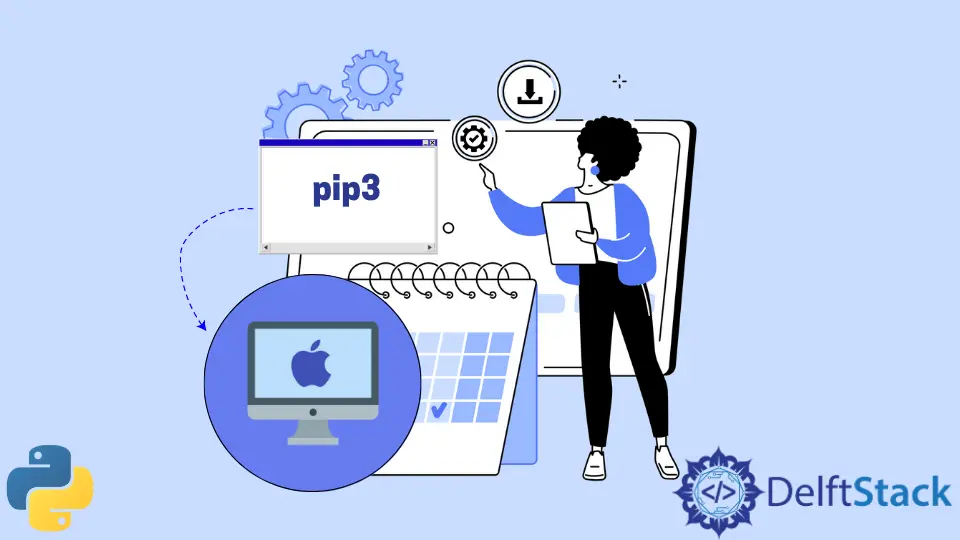How to Install pip3 on Mac
-
Install
pip3on Mac Using theget-pip.pyScript -
Install
pip3on Mac Using theHomebrewPackage Manager -
Using macOS Default Python Installation to Install
pip3on Mac Device -
Use Python Virtual Environment to Install
pip3on Mac - Conclusion

Python is a versatile programming language, and managing packages is essential for any Python development. Pip3, a package installer for Python 3, plays a crucial role in this process.
This article explores various methods to install pip3 on Mac, providing detailed explanations and example codes. We will introduce and demonstrate these methods to help you install pip3 on your Mac device.
Install pip3 on Mac Using the get-pip.py Script
The pip3 is a package manager used to manage packages written in the Python programming language. To install the pip3 package manager, we have to download the get-pip.py file first and save it in the directory of the Python installation.
Use the curl command below to download the get-pip.py file.
curl https://bootstrap.pypa.io/get-pip.py -o get-pip.py
Now, we just have to run the get-pip.py file, and it will automatically install the pip3 package manager on our Mac device. The command to run the get-pip.py file is given below.
python3 get-pip.py
After installing the pip3 package manager, we must verify that the installation was completed successfully. To verify the pip3 package manager, use the command given below.
pip3 --version
This command will give us the version of the current installation of the pip3 package manager on our Mac device.
Install pip3 on Mac Using the Homebrew Package Manager
Homebrew is a known package manager for macOS that simplifies the installation of various tools and libraries. It’s an excellent choice for installing pip3 on Mac.
Instead of downloading the get-pip.py file first and then running it, you can use the Homebrew package manager to install any missing packages on your Mac.
Open Terminal and run the following command to install Homebrew:
/bin/bash -c "$(curl -fsSL https://raw.githubusercontent.com/Homebrew/install/HEAD/install.sh)"
Use Homebrew to install Python 3, which includes pip3:
brew install python3
The code above installs the latest versions of python3 and pip3 on Mac. To verify the installation of the pip3 package manager, we can use the command here:
pip3 --version
The above command will give us the version of the current installation of the pip3 package manager on your Mac device.
Both methods discussed above work just fine, but the first method is more time-consuming and complex. We recommend the Homebrew method to install pip3 and/or python3 on Mac with ease.
The get-pip.py file method is only recommended if, for some reason, the Homebrew method does not work.
Using macOS Default Python Installation to Install pip3 on Mac Device
macOS comes with a default Python installation, and you can use it to install pip3.
Open Terminal and check if Python 3 is installed:
python3 --version
If Python 3 is not installed, you will be prompted to install it. You can also download a Python 3 installer for macOS here.
You can also install Python 3 using Brew:
brew install python3
This method relies on the default Python 3 installation that comes with macOS. If Python 3 is not installed, macOS will guide you through the installation process, or you can use alternative ways to install it.
Use Python Virtual Environment to Install pip3 on Mac
Creating a virtual environment is a good practice for isolating Python projects. You can install pip3 within a virtual environment.
Create a virtual environment by navigating to your project directory and run this command:
python3 -m venv venv
Activate the virtual environment:
source venv/bin/activate
Install pip3 within the virtual environment:
python3 -m ensurepip --default-pip
Example Code:
# Create a virtual environment
python3 -m venv venv
# Activate the virtual environment
source venv/bin/activate
# Install pip3 within the virtual environment
python3 -m ensurepip --default-pip
This method involves creating a virtual environment for your project and then using python3 -m ensurepip --default-pip to ensure that pip3 is installed within the virtual environment.
Conclusion
This guide explores multiple methods to install pip3 on a Mac system. Whether you prefer Homebrew, the default macOS Python installation, the get-pip.py script, or a virtual environment, each method provides a convenient way to manage Python packages and dependencies.
Choose the method that best suits your workflow and requirements, and enjoy a seamless experience in Python development on your Mac.
Maisam is a highly skilled and motivated Data Scientist. He has over 4 years of experience with Python programming language. He loves solving complex problems and sharing his results on the internet.
LinkedIn